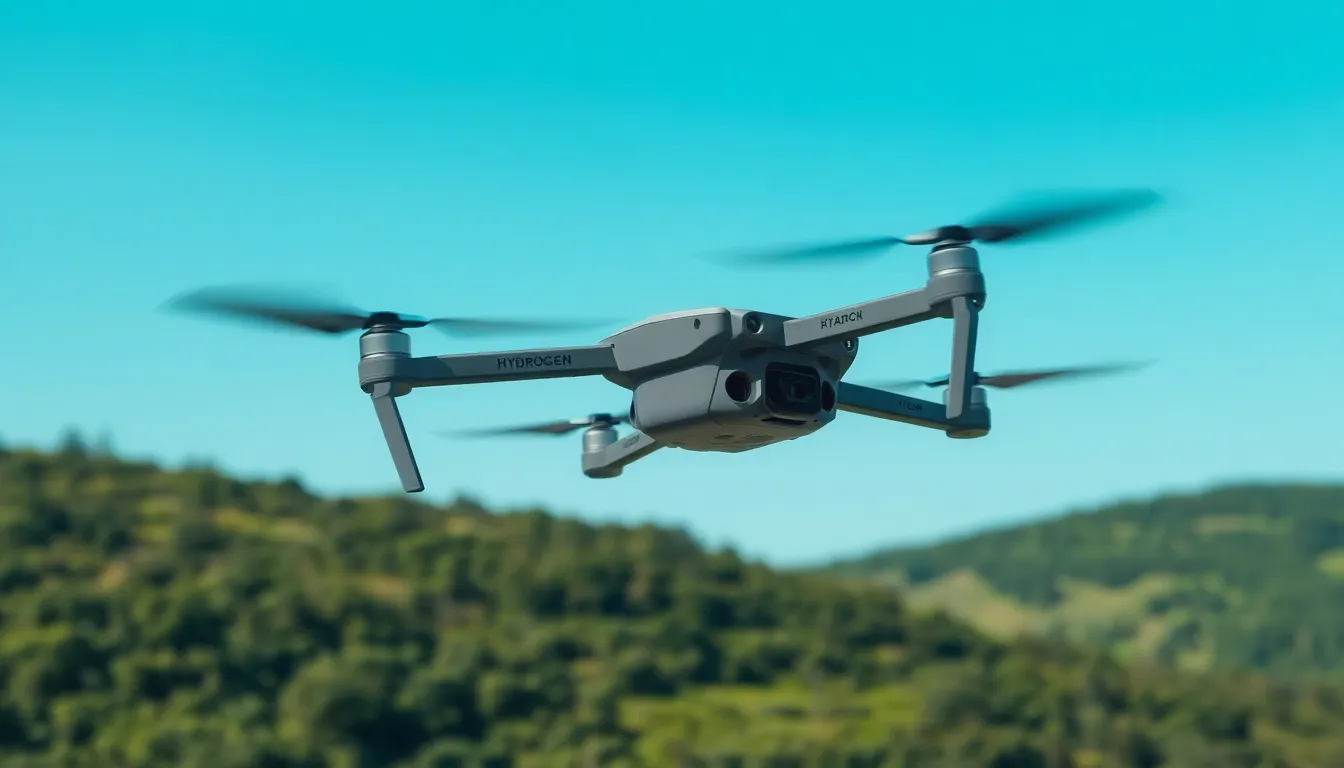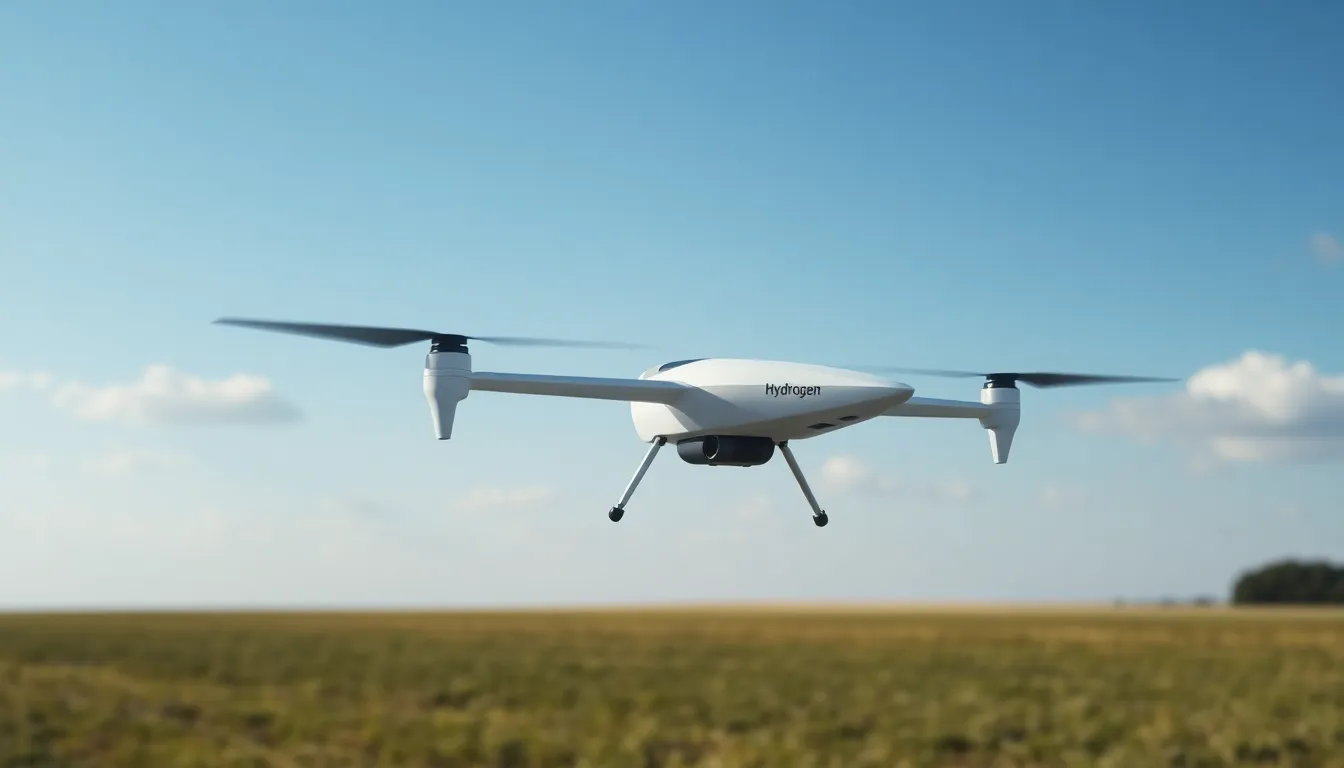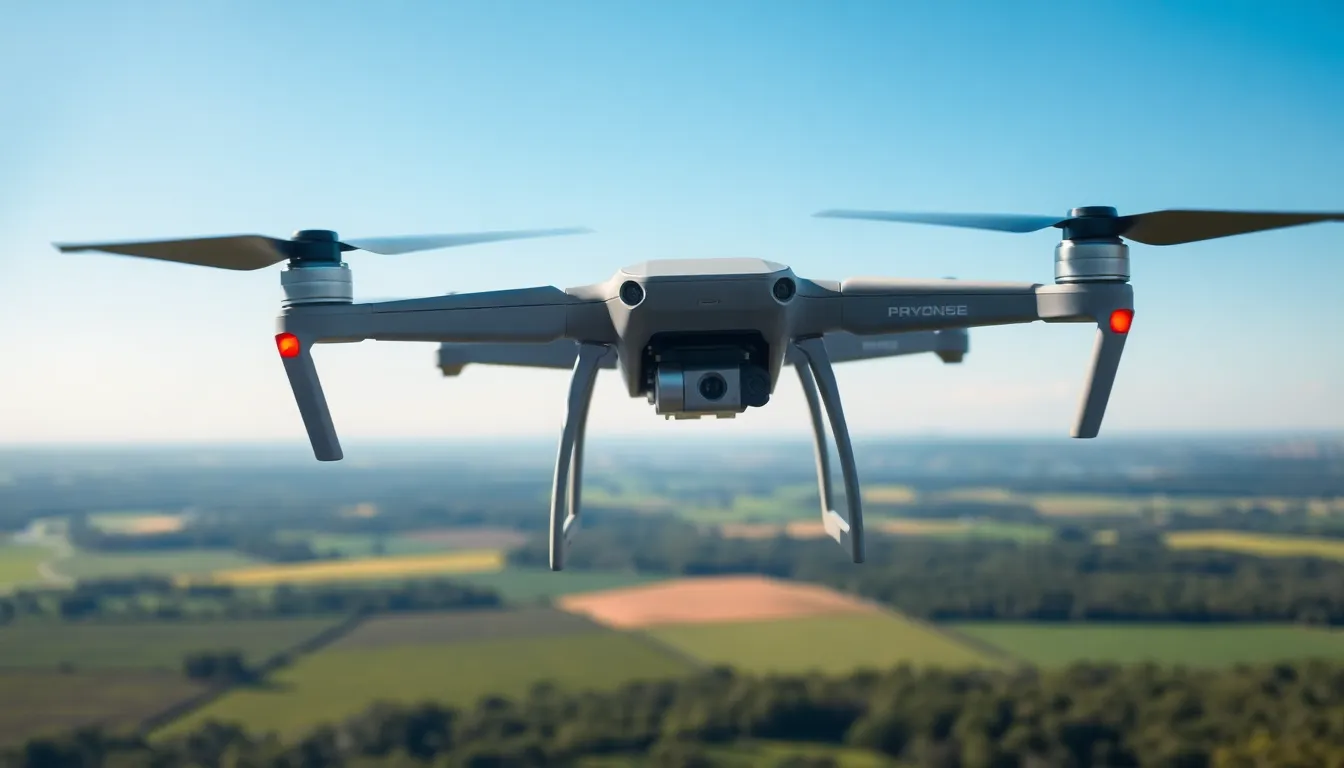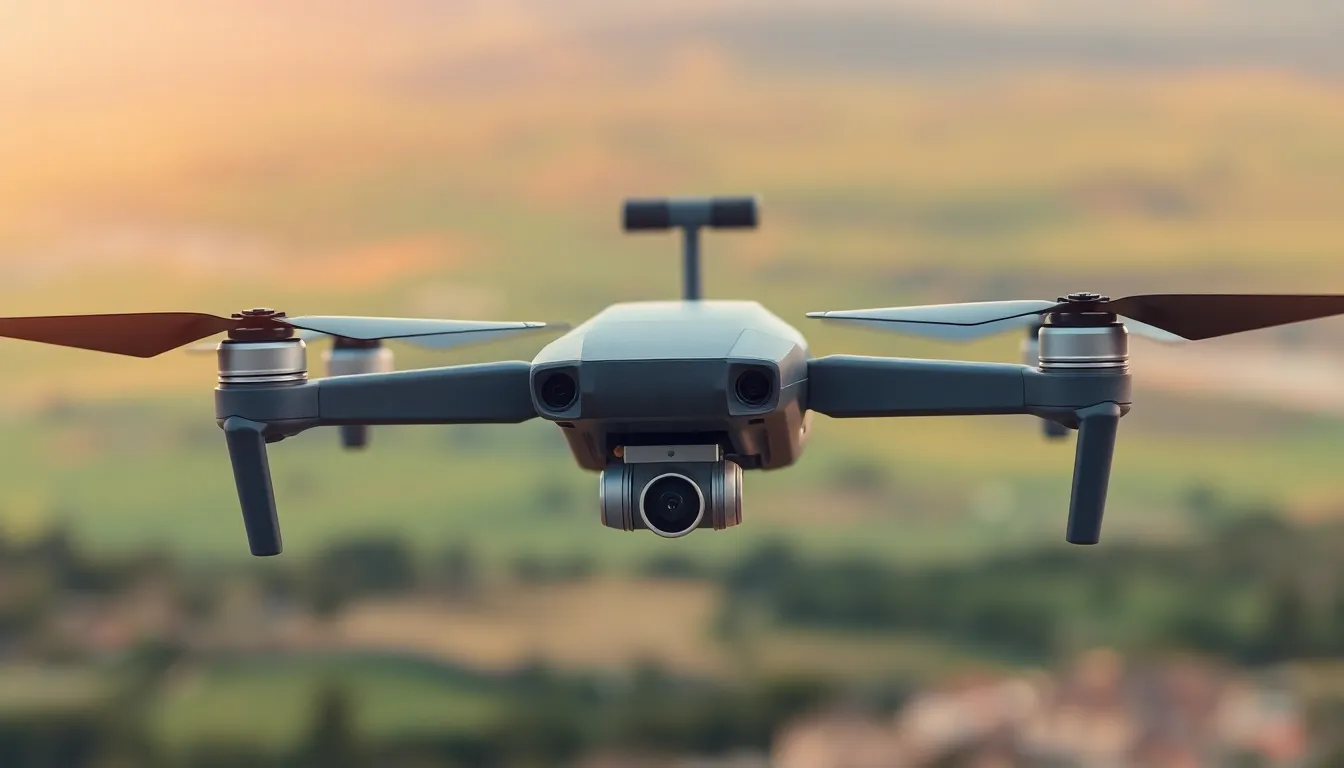Imagine a drone that’s not just flying high but also saving the planet one flight at a time. Enter hydrogen-powered drones, the eco-friendly marvels of the skies that promise to revolutionize the way we think about aerial technology. These flying machines run on hydrogen fuel cells, offering a clean alternative to traditional battery-powered drones. Who knew saving the environment could look so cool?
Table of Contents
ToggleOverview Of Hydrogen-Powered Drones
Hydrogen-powered drones utilize hydrogen fuel cells, offering a clean energy alternative to traditional battery systems. These drones provide longer flight times with less environmental impact, significantly reducing greenhouse gas emissions. Many models can achieve flight durations exceeding 2 hours, compared to the typical 30 minutes of battery-operated counterparts.
Fuel cells convert hydrogen into electricity, powering the drone’s motors efficiently. This technology allows for rapid refueling, often taking just a few minutes, presenting an advantage over battery charging times. Hence, hydrogen fuel cells support continuous operation, especially beneficial for long-range missions in agriculture, surveillance, and disaster response.
Manufacturers like H2Fly and ZeroAvia are leading the way in developing hydrogen-powered drones. These companies are implementing innovative designs that improve aerodynamics and energy efficiency. Various industries are exploring these drones for tasks such as aerial mapping and environmental monitoring, highlighting their versatility.
Safety considerations play a vital role in the deployment of hydrogen-powered drones. Hydrogen’s flammability raises concerns, prompting extensive research into safe storage and handling practices. Industry guidelines ensure operators follow strict protocols to mitigate risks associated with hydrogen use.
Regulatory bodies also assess the operational impact of these drones. Approval processes can vary by region, often requiring compliance with aviation safety standards. As the technology matures, greater emphasis on regulations is expected to smooth the path for wider adoption in commercial applications.
Overall, hydrogen-powered drones present a promising future for aerial technology, balancing operational efficiency with environmental responsibility. As advancements continue, expectations grow for their increased integration into various sectors.
Benefits Of Hydrogen-Powered Drones

Hydrogen-powered drones offer multiple advantages, especially in environmental impact and operational efficiency.
Environmental Advantages
Hydrogen-powered drones produce zero emissions during flight, significantly reducing their carbon footprint. This capability addresses global climate challenges effectively. Using hydrogen as fuel aligns with sustainable practices across industries. Furthermore, the absence of harmful byproducts promotes cleaner air quality. Utilizing hydrogen fuel cells provides a clean alternative to traditional powered models. These systems leverage renewable energy sources for hydrogen production, enhancing overall sustainability. Companies increasingly adopt these drones as part of their green initiatives, showcasing versatility in applications like environmental monitoring and aerial mapping.
Increased Flight Duration
Extended flight times represent another pivotal benefit of hydrogen-powered drones. Many models can sustain flights exceeding 2 hours, far surpassing the typical 30-minute duration of battery-operated devices. This longer range supports various tasks, including long-distance surveillance and agricultural monitoring. Frequent refueling allows for continuous operation, which is critical for urgent missions. Enhanced energy efficiency results from optimized fuel cell technology, ensuring that more payload can be carried without compromising performance. Operators gain increased productivity with fewer interruptions, making hydrogen-powered drones a reliable choice for diverse industries.
Key Technologies In Hydrogen-Powered Drones
Hydrogen-powered drones rely on advanced technologies that enhance their performance and sustainability. Two critical components are fuel cells and hydrogen storage solutions.
Fuel Cells
Fuel cells convert hydrogen into electricity, driving the drone’s propulsion systems. They produce energy efficiently, enabling longer flight times often exceeding two hours. Performance metrics show that hydrogen fuel cells deliver greater energy density compared to traditional batteries. Manufacturers are increasingly focusing on improving fuel cell designs, ensuring they support high thrust and quick response times. These innovations facilitate robust and reliable operation, particularly in demanding environments such as agriculture and surveillance.
Hydrogen Storage Solutions
Hydrogen storage solutions play a vital role in the effective deployment of hydrogen-powered drones. Storage systems utilize high-pressure tanks or lightweight metal hydrides to safely contain hydrogen. These designs maximize storage efficiency while minimizing weight impact on the drone. For example, tanks can store hydrogen at pressures up to 700 bar, providing a significant energy supply without compromising payload capacity. Innovations in storage technology continue to enhance safety, ensuring that drones can operate reliably during extended missions.
Current Applications And Use Cases
Hydrogen-powered drones are finding diverse applications across various industries, showcasing their effectiveness and sustainability.
Delivery Services
Delivery services benefit significantly from hydrogen-powered drones, increasingly adopting them for last-mile logistics. These drones enable faster transport of packages, reducing delivery times compared to traditional methods. For instance, companies utilize hydrogen drones to cover greater distances without frequent refueling stops, enhancing operational efficiency. With flight durations often exceeding 2 hours, deployment in urban areas leads to timely deliveries, especially in hard-to-reach locations. As the demand for speedy delivery continues to grow, hydrogen drones provide a competitive edge, aligning with environmentally conscious practices.
Agricultural Monitoring
Agricultural monitoring leverages the capabilities of hydrogen-powered drones for precise data collection. These drones assist farmers in assessing crop health using advanced imaging technologies. Data gathered includes soil moisture levels, plant growth metrics, and pest infestations, enabling informed decision-making. Sustainable practices enhance through reduced reliance on chemical fertilizers and pesticides. The extended flight range of hydrogen drones allows for wider area coverage, significantly improving agricultural efficiency. Farmers adopting this technology enjoy increased yields while promoting environmentally friendly methods, helping to ensure a thriving agricultural sector.
Challenges And Limitations
Hydrogen-powered drones face several challenges and limitations that impact their widespread adoption in various industries. Addressing these hurdles is crucial for maximizing their potential.
Infrastructure Requirements
Infrastructure is a significant challenge for hydrogen-powered drones. Current refueling stations are limited compared to battery charging points, necessitating investment in new facilities. Developing a widespread network of hydrogen refueling stations ensures accessibility for operators. Moreover, existing logistics systems must adapt to integrate hydrogen supply chains effectively. Significant resources are necessary to establish these infrastructures, particularly in remote or underserved areas.
Safety Concerns
Safety is a paramount concern due to hydrogen’s flammability. Ensuring proper handling and storage protocols is essential for minimizing risks during operation. Manufacturers focus on designing drones with safety features that mitigate potential hazards. Extensive training for personnel involved in maintenance and refueling enhances safety practices. Additionally, stringent adherence to regulatory standards helps maintain safety oversight within the industry. As the technology evolves, ongoing research into improved safety measures remains vital.
Future Trends And Developments
Anticipating significant advancements in hydrogen-powered drones offers exciting prospects for multiple industries. Recent innovations in materials science and engineering improve the structural integrity and weight efficiency of drones. Enhancements in fuel cell technology allow for better energy conversion rates, leading to extended flight durations. Increased investments in research and development expedite breakthroughs that enhance performance metrics and reduce costs.
Government initiatives supporting green energy solutions promote the integration of hydrogen technology in aviation. Regulatory bodies aim to establish standardized protocols, facilitating smoother approvals for commercial use. Global collaborations among industry leaders foster shared knowledge and innovation, driving competitive advantages.
Emerging use cases reflect the versatile applications of hydrogen-powered drones. In logistics, companies deploy these drones for transporting medical supplies in emergency scenarios, showcasing rapid response capabilities. Environmental monitoring becomes more effective with drones conducting real-time assessments over large areas, aiding in conservation efforts.
Public interest in sustainability drives the adoption of hydrogen drones. As environmental awareness increases, industries seek cleaner alternatives that align with global carbon reduction targets. Educational programs on hydrogen technology and drone operation expand the workforce, preparing professionals for future demands.
Market predictions suggest that hydrogen-powered drones may dominate niche applications within five years. Strategic partnerships between technology firms and governmental bodies enhance infrastructure development for fueling stations. Anticipated reductions in operational costs contribute to economic feasibility, promoting broader commercial acceptance.
The hydrogen drone sector faces unique challenges regarding infrastructure connectivity and safety protocols. Focus on developing rigorous training methods for operators emphasizes safe handling practices. Continued dialogue among stakeholders ensures that safety standards evolve alongside technological advancements in the field.
Hydrogen-powered drones are set to transform the aerial technology landscape. Their ability to operate sustainably while delivering enhanced performance makes them an attractive option for various industries. As advancements continue in fuel cell technology and hydrogen storage solutions, the potential applications for these drones will expand further.
The ongoing development of infrastructure and safety protocols will play a crucial role in their adoption. With a growing emphasis on environmental responsibility, these drones not only promise increased efficiency but also align with global sustainability goals. The future looks bright for hydrogen-powered drones, paving the way for innovative solutions in delivery services, agriculture, and beyond.





